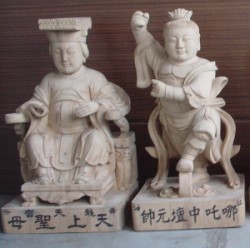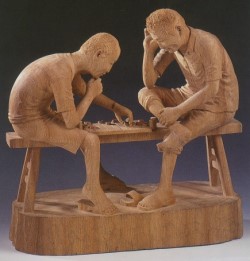|
¡@
   
¡@ |
¡@
Woodcarving
Classification
|
By social function, woodcarving can be classified into religious
woodcarving, workmanship woodcarving, and architectural and
decorative woodcarving. |
|
1. Religious
woodcarving |
|
(1)
Woodcarving of the statues of Buddha
The woodcarving of statues of Buddha in Taiwan
emphasize charm with exquisite carving skills also, affected
by religious believes, traditional rituals and ceremony
rules. One can never be too careful about each step. From
the selection of materials and the day to start carving, to
design, drawing, incanting, and drawing eyes, every step is
very cautious. The carving of each statue is prudent and
solemn.
¡@
¡@ |
 |
|
(2)
Utensils
In addition to the statues, related utensils also have
spiritual power, such as, beast pendant with the Eight
Diagrams, the Five Barracks, peach wood charms against evil,
the Five Thunder Token, baldachins for memorial tablet and
Buddha statues and ancestral tablets, sedan chairs for
deities, and so on.
¡@
¡@ |
 |
|
2. Workmanship
woodcarving |
|
(1) Technical products
Technical products refer to the practical items made in the form of
woodcarving for actual use including furniture, dishes and
chopsticks, fruit bowls, ashtrays, flower beds, flower
stands, and so on. The molds for red turtle cake are the
most common and essential tools for festivals with a variety
of auspicious patterns, such as: turtle, peach, money, fish,
and silver dollar, loved by the public.
¡@ |
 |
|
(2) Handicraft articles
Adhering to traditional skills, focusing on aesthetics, craftsmen
create ornamental and decorative carvings which have gone
beyond the limit of practical needs, become independent
artworks, and emphasize artistry and creators'
personalities.
¡@ |
 |
|
3.
Architectural and decorative woodcarving |
|
Architectural woodcarving can be classified into two
categories, i.e., temples and residence. The main
woodcarving is those for temples. Temples are places for the
gathering of residents and also carriers of excellent
decorative woodcarving art. Woodcarving on accessories and
structures of a building adds beauty and liveliness to the
original monotonous building with exquisite techniques and
functions like pursuit of good fortune and avoidance of
disaster, indoctrination, and so on. The decorative topics
include supernatural being, auspicious animals, landscapes,
flowers and birds, antique artifacts, and historical
stories. Inner expectations are often conveyed by partial
tone. |

(e.g., the
pronunciation of Chinese characters of lian hua (lotus) and
ruyi have similar pronunciation of nian nian ru yi
(Everything goes well every year)). |
|
(Source: Shih, M. L.
(2008), Study of the Cultural Creative Industry of Wood
Carving in Taiwan¡XUsing Lukang Woodcarving as an
Example. The photos are provided by Master Chin-fu Shih
or taken by the team members.) |
|